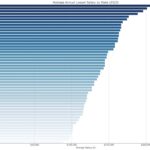Saving money is a cornerstone of financial security, offering a safety net and enabling you to pursue your goals. But in today’s economic climate, figuring out exactly how much of your paycheck should you save can feel overwhelming. This guide breaks down the common recommendations and helps you determine the ideal savings rate for your situation.
Recent research indicates that a significant portion of the population has limited savings. Building a healthy savings habit is therefore not just recommended, it’s essential for navigating unexpected expenses and achieving long-term financial well-being.
Beyond immediate security, savings provide opportunities to capitalize on rising interest rates by paying down high-interest debt, such as credit card balances. Experts consistently advise prioritizing debt reduction, making savings a critical tool in achieving financial stability. Saving also allows you to avoid accumulating new debt for unforeseen expenses and opens doors to professional opportunities and calculated risks.
The challenge then becomes: how do you determine the right amount to save from each paycheck?
The 20% Rule and Other Savings Strategies
The commonly cited rule of thumb is the 50-30-20 budget, where you allocate 50% of your income to needs, 30% to wants, and 20% to savings and investments.
Financial advisor Shon Anderson suggests the “gold standard” of saving 20% of your paycheck might not be applicable to every situation. He proposes another method: an 80-20 divide, with 20% of your paycheck dedicated to savings and the remaining 80% covering your needs and wants. The core principle is maintaining that 20% savings rate regardless of the approach.
In certain high-cost-of-living areas, essential expenses might consume a large portion of income. For instance, with average monthly rent exceeding $2,000 in many parts of the U.S., needs can easily take up 80% or more of a paycheck.
Regardless of the rule you adopt, remember that flexibility and balance between saving and spending are key.
“The point with both these methods is that saving 20% is still a priority,” Anderson emphasizes.
Furthermore, when considering how much of your savings should be invested, prioritize building an emergency fund covering three to six months’ worth of living expenses.
Choosing the Right Savings Account
Once you’ve determined how much to save, the next step is deciding where to keep your money. High-yield savings accounts (HYSAs) are generally the best option, offering significantly higher interest rates compared to traditional savings accounts at brick-and-mortar banks.
Select has consistently ranked LendingClub LevelUp Savings as a top choice, highlighting its competitive APY, currently at 4.40% with monthly deposits of at least $250 (and 3.40% without).
LendingClub LevelUp Savings Account
- Annual Percentage Yield (APY): 4.40% (with monthly deposits of at least $250), or 3.40%
- Minimum balance: None
- Monthly fee: None
(Terms apply. Check LendingClub’s website for the most up-to-date information.)
What if You Can’t Save 20%?
It’s perfectly acceptable if saving 20% of each paycheck isn’t feasible. Financial coach Delyanne Barros emphasizes that “There’s no one-size-fits-all answer here.” If essential costs account for 80% of your paycheck, allocating some of the remaining 20% to discretionary spending is reasonable.
The primary goal is to save some portion of your paycheck, even if it’s just a small amount like $20. Consistent saving, regardless of the amount, builds a habit and makes saving a natural part of your financial routine.
“Starting small and as early as possible can make all the difference in your financial security,” Anderson says.
You can boost your savings by cutting unnecessary expenses. Apps like Rocket Money (formerly Truebill) can help you identify and cancel unwanted subscriptions and negotiate lower bills.
Tailoring Your Savings to Your Goals
Beyond the 20% guideline, consider what you’re saving for. Your savings goals significantly influence how much you should save.
If you’re building an emergency fund to cover several months of expenses, you’ll need a higher savings rate due to the short-term, high-priority nature of the goal. Conversely, if you’re saving for retirement and you’re in your 20s, a savings rate between 10% and 15% might be sufficient to retire by age 60.
Barros also notes that your savings rate depends more on your planned spending than your current income. Someone earning $50,000 living rent-free will likely have lower expenses and different saving capabilities than someone earning $100,000 with rent and family expenses.
Final Thoughts: Consistency is Key
Building a strong financial foundation requires a cash cushion that provides flexibility and peace of mind.
While saving 20% of each paycheck is a useful benchmark, tailoring your savings plan to your individual circumstances is essential. Whether you can save 20% or 5%, prioritizing saving something is always better than nothing. The most important thing is establishing the habit of saving regularly.
